A Paipo
Interview with Gus Acosta
December 25, 2011, and update July 22, 2012 - Big Island, Hawaii
E-mail interview by Bob Green
Photos courtesy of Gus Acosta
Gus's board designs were inspired by hulled trimarans
and ridng the
boogie board of his children. A stand-up surfer for many years he has
been experimenting with finned, fiberglass boards which he calls the
WaveArrow. The WaveArrow manifesto: High speed maneuverability.
|
1. Did you
ride a paipo as a
youth? If so, when and where was this? What type of board did you ride?
Swam, bodysurfed and
surf mated at Trancas Beach, California, then went to a balsa 9'6". I'm
70, and can't make the hop to stand on my 10'2" Edwards, so now I belly
board. I had 25 years of stand-up riding, raised 5 children as an
on-line carpenter, made friends and had a good time.
Gus
with prototypes 1-6. The WaveArrow manifesto: "Aeronautical fore and
aft, three hulls, a distinct body depression, the removal fin box on
the bottom of the keel chine, not on the side. Two leash positions (arm
or leg). The body depression is essential for flexibility. The board
works on any size wave. High speed maneuverability is what we
achieved."
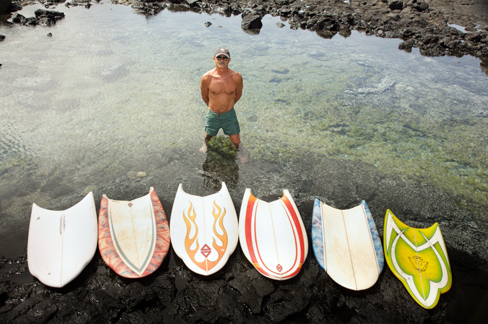
Photo
courtesy of Gus Acosta.
When did you come to Hawaii?
I've moved on and off Hawaii four different times because of the
children and the lame school system here. Not the teachers -- the
system
sucks.
2. Who influenced you as a
shaper? Who else has been involved in making the WaveArrow?
Kudos to Dean Edwards
on Big Island, he broke the ice (and shaped prototypes #1, #2, #5 and
#6). David Souder refined the prototypes of a difficult project
(prototypes #3 and #4). Tim Orr of Pure Life Surfboards transformed the
concept into a beautiful speed machine (shaped prototype #7 -
#11). There are many many, many very creative
and talented shapers out there. My above shaper favorites helped me,
patiently and graciously, what can I say, "Thanks gents." (For more
info see Note 1.)
When was the first WaveArrow made and how has the
design changed?
2002. Three changes, the stern isn't so pronouced, other than that
Dean's interpretation of the design was remarkably right on. Also not
quite as wide.
3. Did you make any paipo
boards before the WaveArrow?
No.
4. What is the background to
your making the WaveArrow?
The need. I started
all my chidren on boogie boards. Wet suits and fins was a Christmas
sensation, two of everything. The twins went to the water like cub sea
otters. The water was chilly but we didn't care. I always have a set of
Churchills in my car. We were in Maui at Guardrails, a nice south swell
hitting. It was slightly too big for the eight-year-olds. I asked them
if they wanted to paddle out. They said, 'No you go out." So I grabbed
one the boards. Anyway, I got lucky, snagged a set wave, "Wow what
fun!" I
saw major speed potential. Kinda went from there. Hard board,
aerodynamic, multi-hull, nothing too far out about that. I like to go
to sea on something substantially seaworthy.
WaveArrow
protoype.
|
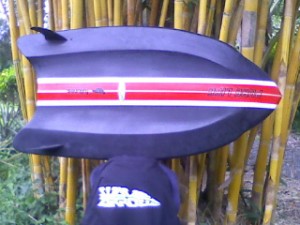
|
|
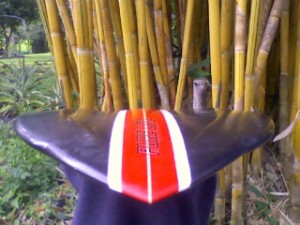
|
Photos
courtesy of Gus Acosta.
WaveArrow
prototype: 52" long (stem to stern), 42" stem to insert, 23-3/4" wide
and 3" thick. "Aeronautical fore and aft and concentric about the
center lines."
|
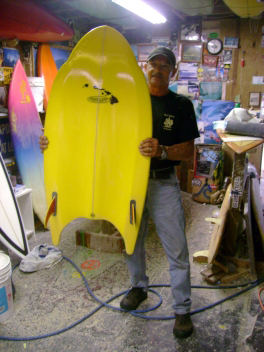
|
|
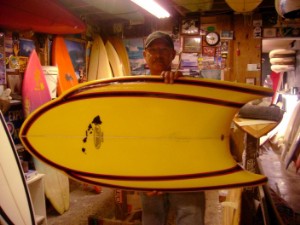
|
Photos
courtesy of Gus Acosta.
5. Can you explain the key
design features and why you think they work? What other features of
your boards contribute to the WaveArrow's performance?
The WaveArow is a
small kind of surfboard, embellished to accommodate
the prone dynamic. The mini trimaran thing comes from experience with
the whole Woody Brown catamaran thing, then triology excursions with
the tri. It works large or small. The fin thing is a must for bottom
turns for me. So prototype #10 is composite of all I know about speed,
form and function! The streamline is an ancient concept. Catamarans
have been around for 2,000 years. Build a small surf board, remove a
section of the stern for hips and kick ability. A port and a starboard
hull, add fins, rig the bottom to enhance the multi-hull dynamic and
you
have yourself a wave craft you can go to sea on and feel well equipped,
"Why not?"
WaveArrow.
"People ask me if its a knee board. My answer is it's whatever gets you
down the line with grace and speed. For me it's prone, I like being
close to the face".
|

|
|
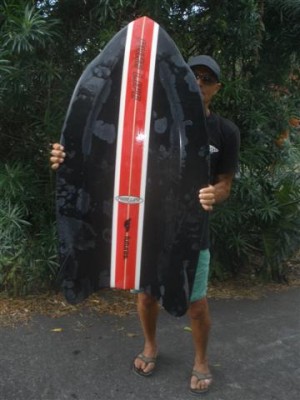
|
Photos
courtesy of Gus Acosta.
WaveArrow.
|
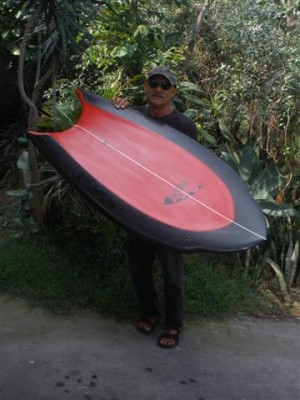
|
|
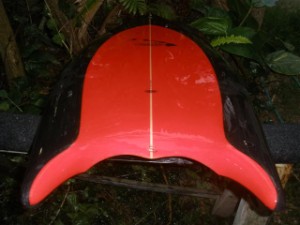
|
Photos
courtesy of Gus Acosta.
WaveArrow.
|
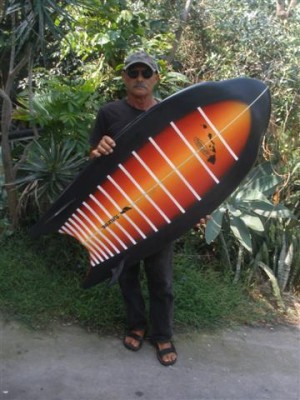
|
|
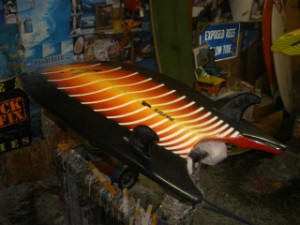
|
Photos
courtesy of Gus Acosta.
6. How does design of a paipo
board
and stand-up board differ?
It doesn't. The
design automatically covers that option. Wally Froiseth was standing up
on a plywood paipo in the 1940s. Where there's a will there's is a way.
One day will probably see some kid wahine blasting out of backdoors.
The boys are already doing it on boogie boards with no fins. Mike
Stewart is the man for one. The beat goes on.
7. Has anyone tried riding a
WaveArrow finless?
No.
8. Any comment on the
techniques required to ride one of your boards, for example, making
them turn or gain speed?
Be polite and
respectful in Church - the line-up. Paddle outside and see what the set
wave is doing. Don't take off on the first wave. Set yourself up for
taking the drop, the more critical the better, go to the bottom, gain
speed,
hang on, adjust, go to the lip and do a Ben Aipa off the lip, then a
couple of Slater's pumps, kick out head for the clouds! etc etc.
Differ, set yourself up again. Lot of waves.
9. Who has been buying and
riding your boards, local guys or from further away?
Chris Tagashike has
given a very good review of riding small Pipeline: "Got 'wet' today in
some small stuff a Pipeline. The board is a keeper Gus. You were right
in that it's faster than what I expected in my old paipos, so much so
that I have to take my time and even stall a little at take off or else
outrun the break. Cutbacks are a breeze and very stable carrying my 205
lbs. ... Had 2 guys come by on the beach and in the water to ask me
about the board, and one guy said, "Wow, it's fast." November 4, 2011."
Lifeguard Rick
on a WaveArrow
|
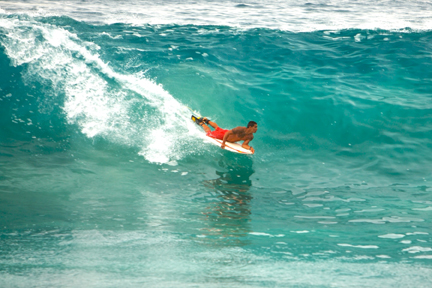
|
|
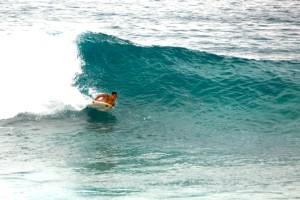
|
Photos
courtesy of Gus Acosta.
10. What type of wave do your
boards go best in?
A head high, warm
point break plus with a couple of buddies.
WaveArrow #10.
|
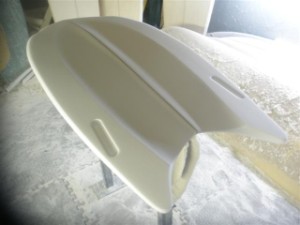
|
|
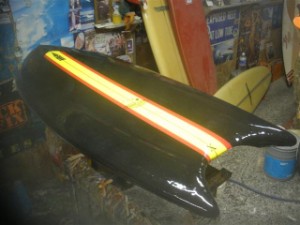
|
Photos
courtesy of Tim Orr.
WaveArrow #11,
shaped 11/11/11.
|
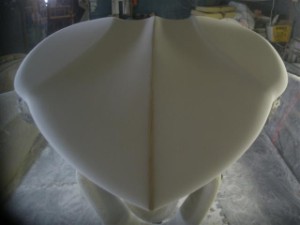
|
|
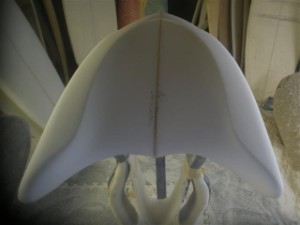
|
Photos
courtesy of Tim Orr.
11. What
direction are you heading with the WaveArrow,
commercially and design wise?
Dean's first board
was so close. Ugh. Anyway I was trying to increase
the hulls, i.e., make the hulls more pronouced, thinner, more flexible
and incorporate removable
fins. Fin position is an issue, the hard rail - soft rail combination.
I've given the WaveArrow ball to Ian Foo to market. He is the main
event in the whole Hypr Nalu stand-up
paddle board provider in Kona. Ian will be bringing the WaveArrow under
his product line name, in three versions:
(1) an all-soft,
fins aeronautical
for and aft etc., body cavity double leash positions;
(2) a hard bottom
soft top, all bells and whistles; and
(3) a carbon fiber all-hard
board.
Small, medium, large and
xxlarge - the hyper extreme. Kudos to him and
all the other shapers: Dean Edwards, Davy Souder and Tim Orr. Oh yeah
the original Hawaiian sovereign nation spelling for paipo is
apparently paepo. Out of respect should we use paepo?
(For a short discussion on
the spelling and usage of the term paipo, see Note 2.)
The
Hypr Nalu Hawaii Paipo Boards (hard boards)
|
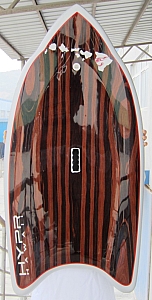
|
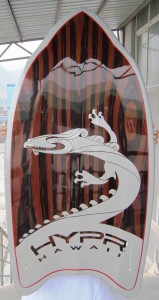
|
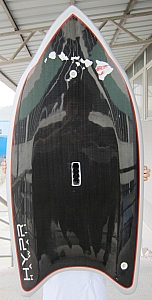
|
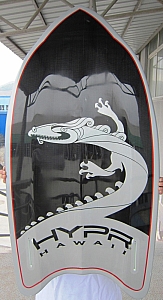
|
The rectangle in the centre of the deck is 1 1/2' deep
handhold to make it easier carrying a WaveArrow. The soft boards were
developed by Ian for beaches that don't allow hard boards.
Photos
courtesy of Gus Acosta. |
Note 1. Tim Orr of Pure Life
Surfboards, Kona, Hawaii, describes
himself as a "Big fan of the Bonzer, and the Campbell Brothers." For
some information on Tim see the SurfCrazy
Stanley's Surf Gear website.
Note 2.
For more information on the etymology of the term paipo, see
Clark, John R. K. 2011. Hawaiian
surfing: traditions from the past. Honolulu: University of
Hawaiʻi Press. From his book,
"In the earliest
descriptions of surfboards by Hawaiian scholars, the smallest boards,
those that were shorter than six feet in length, were generically
called papa li`ili`i, or "small boards." During the early
1900s, the name papa li`ili`i
was changed on two fronts with non-Hawaiian surfers calling them
bellyboards, because they were most often ridden prone, the rider
laying on his or her "belly," and with Hawaiian surfers in Waikiki
calling them pae po`o boards.
Pae po`o is an interesting word. It does not
appear in any Hawaiian dictionaries, Hawaiian language newspapers, or
writings of the prominent Hawaiian scholars of the 1800s, such as `I`i,
Kamakau, Kepelino, and Malo, who described traditional Hawaiian surf
sports. The term appears to have been coined by Hawaiian surfers in
Waikiki circa 1900, where it was commonly used to mean bodysurfing or
bodysurfing with a small wooden bodyboard. The literal translation of pae
po`o is "ride [a wave] head-first", or in other words, bodysurf,
and a papa pae po`o was a bodysurfing board, or what surfers
today call a bodyboard.
In everyday conversation, pae po`o was often shortened to pae
po, which is common among Hawaiian words that end with double
"o's," such as Napo`opo`o on the island of Hawai`i, which is
often pronounced Napopo. The popular spelling used today, paipo,
was coined by Hawaiian surfing legend Wally Froiseth, who, besides
being an excellent surfer, was an exceptional paipo board rider who was
famous for standing on his twin-fin board while riding big waves. From
1956 to 1986, Froiseth made approximately 150 paipo boards, which he
sold to friends and other surfers, putting a decal on each board to
identify it as his product. No one before him, however, had ever
spelled pae po, so without the benefit of seeing the word in
print, Froiseth spelled it as he heard it, pai po."
Other
info:
Acosta, G. (2006). U.S. Patent No. 7074098 - Wave Arrow.
Washington, DC: U.S. Patent and Trademark Office. See PDF file. Also see:
http://www.shop4patents.com/patents/wavearrow.php
Also see an earlier cameo: http://mypaipoboards.org/riders/Gus_Acosta/gus_acosta.shtml
|
|




















